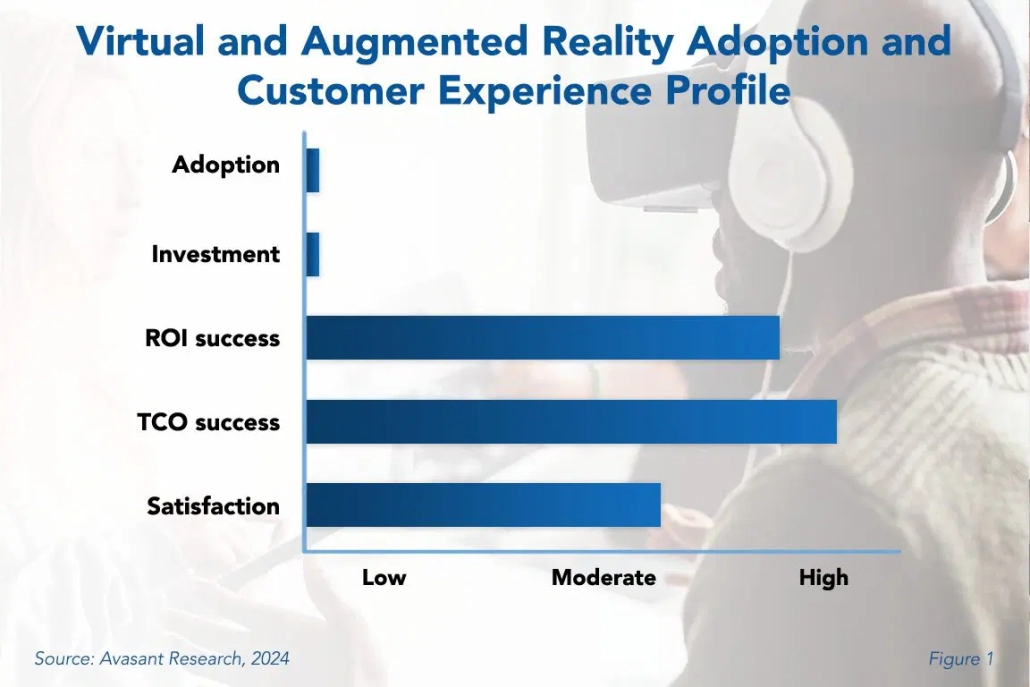Businesses are in the early stages of adopting virtual reality and augmented reality (VR/AR) solutions. While widespread adoption of VR/AR has not yet fully materialized, businesses are actively experimenting with these technologies. However, the ROI and TCO are favorable for early adopters. As the technology improves and use cases are tested, we expect growth in adoption.
As seen in Figure 1 from our full report, Virtual and Augmented Reality Adoption Trends and Customer Experience, VR /AR currently has low adoption and investment, but moderate satisfaction rates. On the other hand, two other metrics—ROI and TCO success—are high. This means that the percentage of organizations at least breaking even on their investments within a two-year period is high compared to other technologies in our full study. Likewise, the percentage of adopters coming in at or less than the budget for implementation and ongoing support costs is also high.

While the technologies are quite similar, there are differences. VR is a computer-generated simulation, usually using a headset, designed to immerse the user entirely in the simulation. In contrast, AR allows the device to overlay the simulation onto the real world instead of immersing the user entirely in it. We expect business use of AR to outpace that of VR in the next three to five years. The fact that AR applications can be deployed on smartphones is another factor in their favor, but both technologies are likely to grow in that time frame.
Challenges persist with VR/AR. Some users report discomfort or motion sickness when using the devices. Others simply find them difficult to get used to. Certain types of devices pose challenges in terms of correct usage if the wearer needs prescription lenses. Some of the AR devices launched have fallen victim to social stigma, especially when worn in public and outside of controlled environments. Moreover, large-scale VR/AR device management is still difficult, especially in training environments. Although the devices’ form factors are becoming smaller and more manageable, issues do persist. Newer devices are addressing some of these problems.
VR/AR technologies have been widely embraced by the gaming and entertainment industries, but real-world problems are also likely to be addressed by these technologies. Consider the potential applications of virtual reality therapy, such as phobia treatment and pain management. Imagine, for example, employing AR to enable technicians to fix complicated machinery or surgeons to operate on patients in remote areas. Moreover, 2024 signals a change toward devices that are lighter, sleeker, and easier to use.
“While VR/AR adoption is currently simmering, the right ingredients could soon bring them to a boil,” said Asif Cassim, principal analyst for Avasant Research, based in Los Angeles. “From a surgeon’s scalpel to classroom walls to training, VR/AR is poised to impact the enterprise.”
Ignoring VR/AR technology is not only a missed opportunity, but a mistake that may result in companies falling behind rivals who are redefining entire industries. Despite the current adoption and investment rates, the notable success in terms of ROI and TCO suggests that companies are indeed obtaining significant value from these technologies. As consumers bring the technology into the enterprise, vendors will become more innovative and creative, allowing the technologies to integrate into existing business processes more smoothly.
Our full report quantifies the current adoption and investment trends for VR and AR, as well as the benefits driving companies to expand their VR and AR implementations. We assess these trends by organization size, sector, and geography and look at the ROI and TCO experiences of organizations that have adopted this technology. We conclude with practical advice for those planning new investments in VR and AR.
This Research Byte is a brief overview of our report on this subject, Virtual and Augmented Reality Adoption Trends and Customer Experience. The full report is available at no charge for subscribers, or it may be purchased by non-clients directly from our website (click for pricing).

